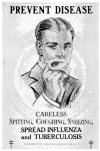"Destroyer and teacher": Managing the masses during the 1918-1919 influenza pandemic
- PMID: 20568568
- PMCID: PMC2862334
- DOI: 10.1177/00333549101250S308
"Destroyer and teacher": Managing the masses during the 1918-1919 influenza pandemic
Abstract
The Spanish influenza arrived in the United States at a time when new forms of mass transportation, mass media, mass consumption, and mass warfare had vastly expanded the public places in which communicable diseases could spread. Faced with a deadly "crowd" disease, public health authorities tried to implement social-distancing measures at an unprecedented level of intensity. Recent historical work suggests that the early and sustained imposition of gathering bans, school closures, and other social-distancing measures significantly reduced mortality rates during the 1918-1919 epidemics. This finding makes it all the more important to understand the sources of resistance to such measures, especially since social-distancing measures remain a vital tool in managing the current H1N1 influenza pandemic. To that end, this historical analysis revisits the public health lessons learned during the 1918-1919 pandemic and reflects on their relevance for the present.
Figures






References
-
- Price GM. Influenza-destroyer and teacher: a general confession by the public health authorities. Survey. 1918;41:367–9.
-
- How infection travels. Literary Digest. 1919;62:88–91.
-
- Markel HM, Lipman HB, Navarro JA, Sloan A, Michalsen JR, Stern AM, et al. Nonpharmaceutical interventions implemented by US cities during the 1918–1919 influenza pandemic. JAMA. 2007;298:644–54. - PubMed
-
- Rosenkrantz B. Public health and the state. Cambridge (MA): Harvard University Press; 1972.
Publication types
MeSH terms
LinkOut - more resources
Full Text Sources
Medical

